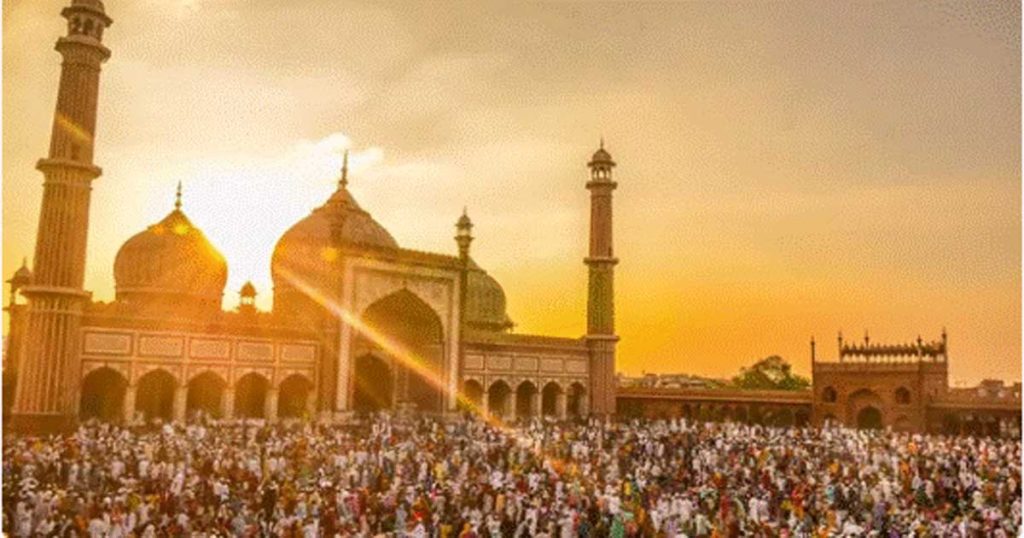Eid 2023 date in Saudi Arabia, India: Here’s when Ramadan will end and Muslims will mark Chand Raat and Eid-ul-Fitr in Middle East, India, other countries
Chand Raat is a term used in South Asian cultures, particularly in India, Pakistan and Bangladesh, to refer to the night before Eid-ul-Fitr or Eid al-Adha where “Chand” means moon and “Raat” means night in Urdu, so the term refers to the night when the Muslims sight the crescent or new moon, signaling the end of the month of Ramadan or the month of Zul-Hijjah. It is a festive night where people go out shopping for new clothes, bangles and other items to wear on the day of Eid as the markets are usually bustling with activity and people celebrate by eating sweets, exchanging gifts and greeting each other with Eid Mubarak (Blessed Eid) as this important cultural event marks the end of a period of fasting and is a time of celebration with loved ones.
The festive night of chand raat is followed by Eid-ul-Fitr celebrations in the morning, which is a major religious holiday celebrated by Muslims all over the world as it marks the end of the month-long fasting period of Ramadan, during which Muslims abstain from food and drink from sunrise to sunset hence, Eid-ul-Fitr is also known as the “Festival of Breaking the Fast.” The ninth month in the Islamic Lunar Calendar is Ramadan and the tenth is Shawwal whose first day is marked as Eid-ul-Fitr across the world.
While the West culturally follows the Gregorian calendar, the Islamic calendar is lunar which means it is based on the sighting of the crescent moon. Every year, Eid-ul-Fitr occurs approximately 10-11 days earlier depending on when the crescent moon is sighted since lunar months are shorter than solar months and so it varies from country to country by about a day.
Muslims in Saudi Arabia, UAE, Oman, Qatar, Kuwait, Bahrain, Egypt, Turkey, Iran, United Kingdom and other countries in the Middle East and West will gear up to sight the crescent moon on Thursday i.e. April 20 evening, after breaking the Ramadan fast at maghrib or evening payers. If the crescent moon is sighted, chaand raat will be on Thursday which marks the onset of the Islamic month of Shawwal and the day of Eid-ul-Fitr will be celebrated the next day i.e. April 21, 2023 but if the Shawwal crescent is not sighted on Thursday evening, Chand Raat in these countries will be on Friday April 21 while Eid-ul-Fitr will be celebrated on April 22, 2023.
As per the United Kingdom’s HM Nautical Almanac Office, the Shawwal crescent moon will be visible at 04:13 GMT on Thursday, April 20 but will only be visible across North America under certain conditions while a majority of the world should be able to easily sight the new moon with the naked eye the following night i.e. Friday, April 21, meaning the first day of Eid will be Saturday, April 22. Unless conditions are ideal or if they use an optical aid, a handful of countries in the southern hemisphere, including parts of South America, Australia and New Zealand, might not sight the cresent on Friday night so Muslims in those countries will celebrate Eid on Sunday, April 23.
Indian Muslims and those in other South Asian countries will gear up to sight the crescent moon on Friday i.e. April 21, after breaking the Ramadan fast at maghrib or evening payers. If the crescent moon is sighted, chaand raat will be on Friday night which will mark the onset of the Islamic month of Shawwal and the day of Eid-ul-Fitr will be celebrated the next day i.e. April 22, 2023.
Otherwise, Muslims in India and other South Asian countries will continue to fast on Friday and Eid-ul-Fitr will be celebrated on Sunday i.e. April 23, 2023. The buzz of chaand raat is however, unmissable in the air as this is the time of celebration when families and friends gather on the terrace of their homes or courtyards or parks or any open places at the end of the last day of Ramadan to spot the crescent moon.
Chaand raat is a witness to cauldrons of desserts being cooked, houses whitewashed and lit, streets decorated and women applying mehndi or henna designs on their hands, all in preparation of Eid the next day. On the day of Eid-ul-Fitr, Muslims wake up early in the morning, take a bath and wear new clothes, then gather in mosques or open areas for special Eid prayers, which are followed by a khutbah or sermon by the Imam (religious leader).
After the prayers, people exchange greetings of “Eid Mubarak” and hug each other as a sign of brotherhood while giving alms to the poor. Muslims celebrate Eid-ul-Fitr with feasting and giving gifts to family, friends and the less fortunate where many families prepare special dishes for Eid, such as sheer khurma (a sweet vermicelli pudding), biryani (a meaty rice dish) and other sweets while children often receive gifts and money, which is known as “Eidi.”
Eid-ul-Fitr is a time of joy, unity and compassion for Muslims, who use the occasion to strengthen their bonds with family and friends and to reach out to those in need. It is a time to express gratitude to Allah for His blessings and to seek His forgiveness for any sins committed during Ramadan.
Source : Hindustan Times
